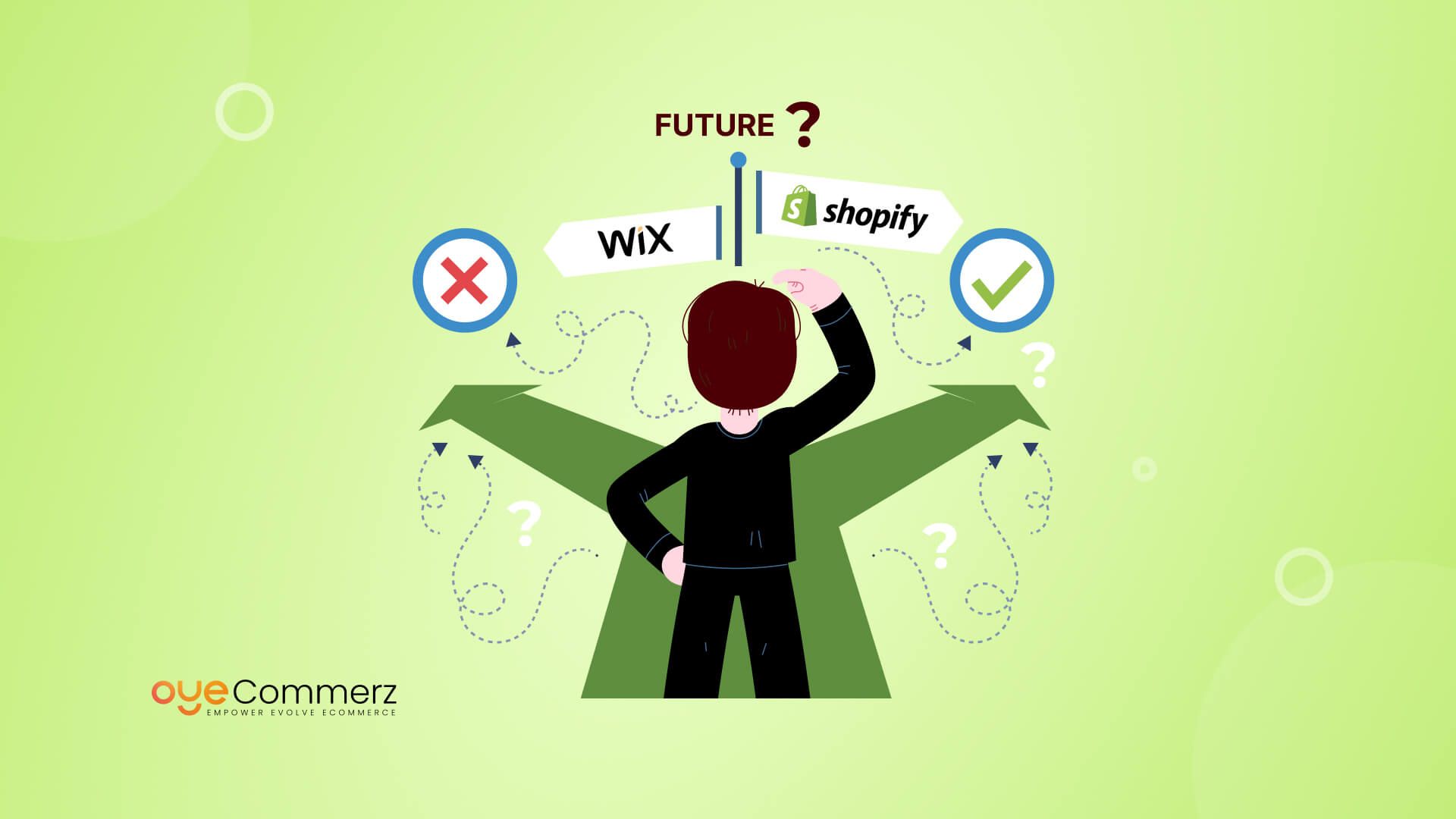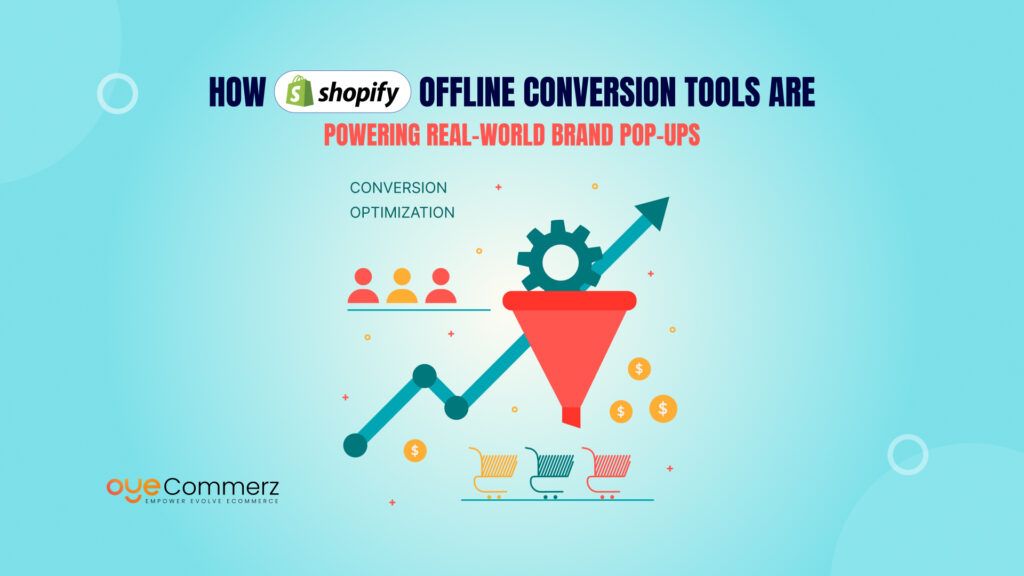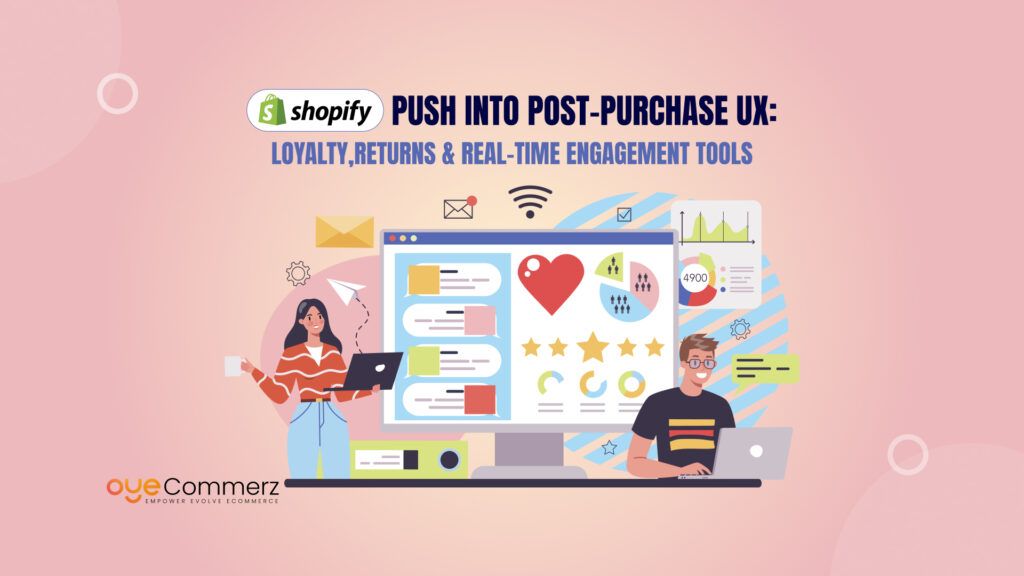Is your Wix store ready to grow with your ambitions? Relying on tools that can’t adapt to your business needs, often ends up slowing progress and creating unnecessary challenges. This isn’t just a small issue for existing Wix store owners, it’s the difference between thriving and merely surviving. Shopify isn’t just another platform; it’s a blueprint for building a future-proof business. Brands that switch to Shopify often experience up to 40% faster sales growth, thanks to its unmatched scalability and innovation. In this blog, we’ll unpack Wix owners’ real struggles and show you why Shopify is designed to help your business not just last—but lead. Ready to level up? Let’s get started!
Table of Contents
ToggleWhy Future-Proofing Is Important for E-Commerce Businesses
The e-commerce landscape is rapidly evolving, driven by technological advancements, shifting consumer behaviors, and increasing competition. For businesses, ensuring their platform can adapt to these changes is not just an advantage—it’s essential for survival. Future-proofing your e-commerce platform means setting up your business for long-term growth, scalability, and innovation. Here’s why this matters:
Adapting to Changing Consumer Expectations
Consumers today demand more than just basic online shopping. They expect:
- Personalized Shopping Experiences: Dynamic product recommendations and tailored content are becoming the norm.
- Fast Delivery Options: Same-day or next-day delivery is now an expectation, not a luxury.
- Multichannel Experiences: Shoppers want seamless integration across platforms like websites, apps, and social media.
An e-commerce platform must evolve to meet these demands. Platforms like Shopify are designed to stay ahead of these trends, while Wix needs help to provide the advanced features necessary to keep up.
Scalability for Growth
As your business grows, so do your requirements. Future-proofing ensures that your platform can handle:
Shopify’s architecture excels in scalability, accommodating businesses of all sizes. Wix, on the other hand, often faces challenges when scaling up for larger operations.
Staying Competitive
Emerging technologies like artificial intelligence (AI), augmented reality (AR/VR), and automation are transforming the way businesses interact with customers. A future-proof platform like Shopify integrates these innovations seamlessly, giving businesses a competitive edge. Wix, with its limited flexibility, often lags, leaving businesses unable to leverage these game-changing technologies.
Global Expansion Capabilities
Cross-border selling is no longer an option—it’s a necessity. Future-proofing your e-commerce business means equipping your platform with tools for:
- Multi-Currency Support: Ensuring customers can shop in their local currencies.
- Tax Compliance: Managing international tax regulations effortlessly.
- Localized Experiences: Providing region-specific content, shipping options, and payment methods.
Shopify simplifies global expansion with built-in features, while Wix requires heavy customization and third-party integrations, often complicating the process.
Mitigating Technology Obsolescence
Technology moves fast, and outdated platforms can quickly become a liability. Businesses on platforms like Wix often face:
- Limited Innovation: Wix’s updates are more website-focused, not tailored to e-commerce advancements.
- Integration Gaps: Lack of compatibility with cutting-edge tools and software.
- Restricted Customization: Difficulty in adapting the platform to modern business needs.
In contrast, Shopify regularly invests in innovation, ensuring that businesses have access to the latest tools, integrations, and features. This proactive approach keeps your business at the forefront of e-commerce.
Challenges Wix Faces in Meeting E-Commerce Future Needs

Wix, while popular as an intuitive website builder, often falls short when it comes to meeting the demands of modern e-commerce businesses. Built primarily for creating basic websites, Wix’s infrastructure and feature set present several limitations that make scaling and sustaining a competitive online store challenging. Below, we explore these challenges in detail.
1. Limited E-Commerce Capabilities
Wix’s foundation as a website builder rather than a dedicated e-commerce platform creates inherent limitations in its ability to support complex business needs.
These gaps leave businesses struggling to meet customer expectations or expand into new markets. In contrast, Shopify’s e-commerce-first approach ensures robust tools to support even the most demanding operations.
2. Scalability Issues
As businesses grow, their operational complexities increase. Wix’s infrastructure is not designed to handle high transaction volumes or large catalogs, leading to performance bottlenecks.
Key Scalability Challenges with Wix:
- Traffic Handling: During peak periods like sales or holiday promotions, Wix stores often experience slower load times, frustrating customers and reducing conversions.
- Product Catalog Limitations: Managing a catalog of thousands of products on Wix can become cumbersome, with slower backend performance and limited organizational tools.
- Transaction Volume: Wix struggles to process high transaction volumes efficiently, making it less suitable for growing businesses.
Shopify, on the other hand, is designed to scale effortlessly. Its infrastructure supports businesses of all sizes, ensuring smooth operations regardless of traffic spikes or catalog size.
3. Lack of Customization
For businesses looking to create unique customer experiences or tailor their workflows, Wix’s limitations in customization can be a significant drawback.
Shopify’s flexibility empowers businesses to innovate, while Wix’s rigid framework often forces businesses to compromise on their vision.
4. Performance Concerns
Page load speed is a critical factor in user experience and search engine optimization (SEO). Wix’s platform often falls short of delivering optimal performance for e-commerce businesses.
- Slower Load Times: Wix’s reliance on a one-size-fits-all approach for hosting can lead to slower page loads, especially for larger stores.
- Impact on Conversions: Studies show that even a one-second delay in load time can reduce conversions by up to 7%.
- Limited Global CDN: Wix’s content delivery infrastructure is less robust compared to Shopify’s global CDN, which ensures fast load times regardless of user location.
For businesses aiming to build a future-proof business, Shopify’s performance optimizations ensure smooth and reliable operations, even during high-traffic events.
5. SEO and Marketing Gaps
Effective marketing and SEO are critical for driving traffic and conversions. Wix offers basic tools in these areas but lacks the advanced features needed to compete in the dynamic e-commerce space.
With fewer native options for marketing and SEO, Wix users often rely on third-party tools, increasing costs and complicating workflows. Shopify, with its built-in features and seamless integrations, provides a complete solution for driving traffic and boosting sales.
Shopify: Built to Support Businesses Today and Tomorrow
Unlike Wix, which was designed as a general-purpose website builder, Shopify is purpose-built for e-commerce, offering a comprehensive solution for businesses looking to thrive in a competitive marketplace. Let’s explore why Shopify stands out.
1. Purpose-Built for E-Commerce
Shopify is designed exclusively for online selling, making it a powerful and focused platform.
This specialized focus ensures that Shopify meets the unique needs of e-commerce businesses, unlike Wix, which lacks the depth and sophistication required for complex operations.
2. Scalable for Businesses of Any Size
Whether you’re a startup or an established enterprise, Shopify’s architecture is designed to grow with you.
Key Benefits of Shopify’s Scalability:
- Seamless Traffic Handling: Shopify ensures uptime and performance during high-traffic events like Black Friday.
- Support for Large Catalogs: Manage thousands of products effortlessly with Shopify’s organized backend tools.
- Enterprise Features: For larger businesses, Shopify Plus offers advanced features like automation and B2B capabilities.
Wix, by comparison, struggles to support growing businesses, often requiring costly upgrades or workarounds to handle increased demands.
3. Customization and Flexibility
When it comes to creating a unique and tailored shopping experience, Shopify far outshines Wix. For e-commerce businesses, the ability to adapt a platform to their specific needs is crucial for standing out in a crowded market. Shopify provides unparalleled customization options, enabling businesses to craft a store that aligns with their brand identity and operational requirements.
Theme and Design Flexibility
Shopify offers a wide range of professionally designed themes, both free and premium, that are fully customizable. Businesses can modify themes using:
- Shopify Liquid: A developer-friendly templating language that allows deep customization of the store’s design.
- Drag-and-Drop Builder: For non-technical users, Shopify’s user-friendly builder makes basic changes quick and easy.
In contrast, Wix’s customization is limited to pre-built templates that are harder to modify for advanced or unique design needs. This restricts businesses from creating a truly distinctive brand experience.
Backend Customization
Shopify excels in backend flexibility, allowing businesses to integrate tools, apps, and features that match their workflows.
Shopify empowers businesses with the tools to innovate, while Wix’s limitations often force users to conform to its standard features.
Tailored Shopping Experiences
Shopify allows businesses to create personalized shopping experiences that boost customer engagement and sales. Features include:
- Dynamic Product Recommendations: AI-powered suggestions based on customer behavior.
- Custom Checkout Options: Modify the checkout process to fit specific requirements, such as B2B transactions or international customers.
- Localized Experiences: Support for multiple languages and currencies ensures a seamless global shopping experience.
Wix struggles to offer these advanced features, leaving businesses unable to meet the expectations of modern consumers.
4. Superior Performance
Performance is a critical factor for e-commerce success, directly impacting user experience, search engine rankings, and conversion rates. Shopify’s robust infrastructure ensures fast, reliable performance, even under the pressure of high traffic and large operations. Wix, on the other hand, faces significant challenges in this area.
Page Load Speed
Shopify’s global Content Delivery Network (CDN) ensures fast page load times for users anywhere in the world. Key advantages include:
- Optimized Server Locations: Content is delivered from the nearest server, reducing latency.
- Lightweight Themes: Shopify themes are optimized for performance, ensuring a smooth browsing experience.
Wix’s slower load times often frustrate users, leading to higher bounce rates and lost sales opportunities.
Reliability During high-traffic
Shopify’s infrastructure is built to handle surges in traffic, making it ideal for businesses running promotions or seasonal sales. Benefits include:
- 99.99% Uptime: Reliable performance even during events like Black Friday or Cyber Monday.
- Automatic Scaling: Shopify adjusts resources dynamically to ensure stability under heavy loads.
Wix lacks this level of reliability, with many users reporting slowdowns or outages during peak periods.
SEO-Optimized Performance
Shopify’s commitment to speed and optimization extends to its SEO features. Faster load times lead to better rankings on search engines, while Shopify’s built-in SEO tools help businesses improve visibility.
Advanced Marketing and SEO Features
Shopify goes beyond performance with built-in marketing and SEO tools that help businesses drive traffic, engage customers, and boost sales.
- Dynamic Upselling and Cross-Selling: Automatically suggest relevant products to increase average order value.
- Abandoned Cart Recovery: Shopify’s system sends automated follow-up emails to bring customers back to complete their purchases.
- Social Media Integration: Seamlessly connect with platforms like Facebook, Instagram, and TikTok to run campaigns and sell directly.
Wix’s marketing tools, while functional, lack the depth and automation capabilities of Shopify, requiring businesses to rely heavily on third-party solutions.
Future-Ready Innovations: The Shopify Edge
E-commerce is an ever-evolving industry, where adopting emerging technologies is crucial to staying ahead of the curve. Shopify’s commitment to innovation ensures that businesses using the platform are always equipped to meet future challenges and opportunities. This focus makes Shopify a leader in creating future-proof businesses.

AR/VR Shopping Experiences
Shopify’s investment in augmented reality (AR) and virtual reality (VR) is revolutionizing the online shopping experience. These technologies help customers visualize products more effectively, reducing uncertainty and increasing purchase confidence.
AI-Powered Recommendations
Shopify integrates artificial intelligence (AI) to deliver personalized shopping experiences. Key features include:
- Dynamic Product Suggestions: AI analyzes user behavior to recommend relevant products in real time.
- Customer Segmentation: AI groups customers based on preferences and purchase history, enabling targeted marketing campaigns.
These features not only enhance customer satisfaction but also drive repeat purchases. Wix’s limited AI capabilities leave businesses unable to fully leverage the power of personalization.
Multichannel Selling
Shopify enables seamless selling across multiple platforms, including:
- Social Media: Direct integration with Instagram, TikTok, and Facebook for product tagging and in-app purchases.
- Marketplaces: Simplified connections to Amazon and eBay for expanded reach.
- Offline Channels: Shopify POS (Point of Sale) for unified inventory and sales tracking across online and physical stores.
This level of multichannel integration ensures that businesses can adapt to changing consumer shopping habits, something Wix struggles to achieve.
Continuous Updates and Innovations
Shopify’s development roadmap prioritizes adding value for merchants by frequently rolling out updates and new features. Recent advancements include:
- Headless Commerce: Allows businesses to create custom front-end experiences while leveraging Shopify’s robust backend.
- Automation Tools: Shopify Flow enables businesses to automate routine tasks, saving time and reducing errors.
- Global Commerce Enhancements: Improvements in multi-currency support, international tax handling, and localized storefronts.
Wix’s slower update cycle often leaves users waiting for essential features or workarounds, creating challenges for businesses trying to innovate.
Shopify vs. Wix: A Comparative Analysis
Choosing the right e-commerce platform is a critical decision that can impact your business’s growth and success. While Wix offers simplicity and ease of use, Shopify is purpose-built for e-commerce, providing robust tools and scalability for businesses looking to thrive in the competitive online marketplace. Shopify powers approximately 5.23 million live websites globally, underscoring its widespread adoption and reliability among e-commerce businesses. Let’s explore how Shopify outshines Wix across key areas.
1. E-Commerce Features
Shopify’s comprehensive e-commerce features are tailored for businesses of all sizes. From managing inventory to enabling multi-channel sales, Shopify offers tools designed to scale with your business.
- Product Management: Shopify allows bulk editing, tagging, and advanced inventory tracking, making it ideal for businesses with large catalogs. Wix’s product management tools are more basic and struggle with complexity.
- Checkout Flexibility: Shopify supports multi-currency, multi-language, and customizable checkout experiences. Wix offers standard checkout with fewer customization options.
- Shipping and Fulfillment: Shopify integrates real-time shipping rates, advanced tracking, and automated returns management. Wix provides limited shipping features that may not meet the needs of growing businesses.
2. Performance and Reliability
Shopify’s infrastructure ensures fast, reliable performance, even during high-traffic periods. Its global Content Delivery Network (CDN) delivers content quickly to users worldwide, reducing latency and improving page load times.
Wix, while adequate for small websites, often face performance issues under heavy traffic. Businesses experiencing growth may encounter slower load times and occasional downtimes, which can negatively impact user experience and sales.
3. Customization and Integrations
Shopify offers unparalleled customization options through its developer-friendly tools, including Shopify Liquid for theme edits and APIs for backend modifications. The Shopify App Store provides thousands of apps to enhance functionality, covering everything from AI-driven marketing to advanced analytics.
Wix’s customization capabilities are limited to its templates, and its smaller app marketplace restricts the ability to integrate advanced features. For businesses requiring unique workflows or industry-specific solutions, Shopify is the clear winner.
4. Total Cost of Ownership
While Shopify may have higher upfront costs, its robust features and scalability deliver greater long-term value. Businesses save on third-party integrations and enjoy seamless upgrades as their operations expand.
Wix’s lower initial costs can be appealing, but scaling often incurs hidden expenses, such as paying for additional apps or encountering limitations that require costly workarounds.
Migrating from Wix to Shopify: A Future-Proof Strategy

Switching platforms can seem daunting, but for businesses looking to scale and future-proof their operations, migrating from Wix to Shopify is a game-changing move. Shopify’s advanced tools, scalability, and ease of use make it the preferred platform for businesses ready to thrive in today’s fast-paced e-commerce landscape. Here’s a detailed guide to help you transition seamlessly.
1. Why Businesses Are Switching to Shopify
The limitations of Wix, as outlined earlier, compel businesses to explore platforms that better align with their growth ambitions. Shopify offers:
- Scalability: Handles high traffic and large catalogs effortlessly.
- Advanced E-Commerce Features: From multi-channel selling to robust inventory management, Shopify is built for growth.
- Customization Options: Tailor your store’s design, functionality, and workflows to your unique needs.
- Future-Proofing: With cutting-edge innovations and continuous updates, Shopify ensures your store stays competitive.
By switching to Shopify, businesses overcome Wix’s bottlenecks and gain access to tools designed to support their success.
2. Step-by-Step Migration Guide
Migrating to Shopify involves careful planning and execution. Follow these steps for a smooth transition:
Step 1: Evaluate Your Current Store
- Inventory Check: Audit your existing product catalog, ensuring accurate titles, descriptions, and pricing.
- Data Backup: Export all necessary data, including customer information, order history, and SEO metadata.
Step 2: Prepare Your Shopify Store
- Choose a Theme: Select a Shopify theme that aligns with your brand and business goals. Use the drag-and-drop editor or Shopify Liquid for customization.
- Set Up Apps and Integrations: Identify the apps you’ll need for email marketing, analytics, SEO, and more.
- Organize Collections: Structure your products into collections for easier navigation and a better user experience.
Step 3: Migrate Your Data
- Product Data: Use Shopify’s import tools or third-party migration apps to transfer your product catalog.
- Customer Data: Import customer records, including contact information and purchase history, to ensure a seamless transition.
- SEO Settings: Preserve your SEO rankings by redirecting Wix URLs to your new Shopify store.
Step 4: Test Your Shopify Store
- Performance Testing: Check for page load speed and functionality across devices.
- Checkout Simulation: Ensure the checkout process is smooth and error-free.
- App Integrations: Verify that all apps and integrations are working as intended.
Step 5: Launch and Optimize
- Go Live: Once satisfied with testing, launch your Shopify store.
- Marketing Campaigns: Announce the transition to your customers via email and social media.
- Monitor Performance: Use Shopify’s analytics tools to track performance and identify areas for improvement.
3. Optimizing Shopify Post-Migration
After migration, focus on leveraging Shopify’s powerful tools to maximize your store’s potential:
- Enhance User Experience: Utilize Shopify’s dynamic recommendations, fast load times, and mobile optimization.
- Leverage Marketing Tools: Take advantage of features like abandoned cart recovery, discount management, and social media integration.
- Prepare for Growth: Add apps or hire Shopify experts to build custom features as your business expands.
By addressing these unique needs of US-based businesses, Shopify solidifies its position as a platform that not only meets current demands but also anticipates future trends. Next, we’ll guide you on how to transition seamlessly from Wix to Shopify, ensuring you take full advantage of Shopify’s powerful marketing features.
Ready to Future-Proof Your Business with OyeCommerz?
Your e-commerce success starts with the right foundation. OyeCommerz, powered by Shopify, is your ultimate partner in building a thriving, scalable, and future-ready online store. Whether you’re upgrading from Wix or starting fresh, OyeCommerz ensures your business is equipped with cutting-edge tools, expert support, and seamless integrations to help you grow.
Why Choose OyeCommerz?
- Customized Shopify Solutions: Tailored to your unique business needs.
- Hassle-Free Migration: Smooth transition from any platform, including Wix.
- Future-Proof Features: AI, AR, multi-channel selling, and more.
- Dedicated Support: Guidance at every step, from setup to scaling.
Your Next Move:
Don’t wait for your competitors to outpace you. Take charge of your e-commerce future with OyeCommerz.
Click Here to Get Started – Let’s build the future of your business today!
Contact to Migrate your Site to Shopify Now
Final Thoughts
Wix may work for basic needs, but as your business grows, its limitations in scalability, customization, and performance can hold you back. Shopify, purpose-built for e-commerce, offers the advanced tools, flexibility, and innovation needed to thrive in today’s dynamic market.
If you’re ready to future-proof your business and unlock new growth opportunities, Shopify is the platform to make it happen. LeapWhy today—your future starts now.




